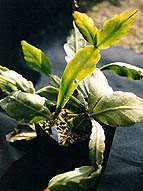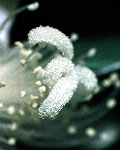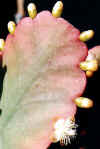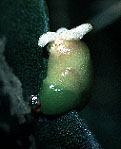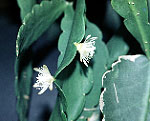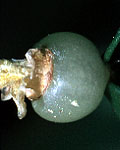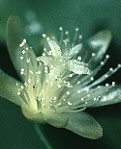|
Top row, second from left, taken at Huntington Botanical Gardens, 9/99 KAF.
Top row, far right, by Derek Butcher, opens in another window.
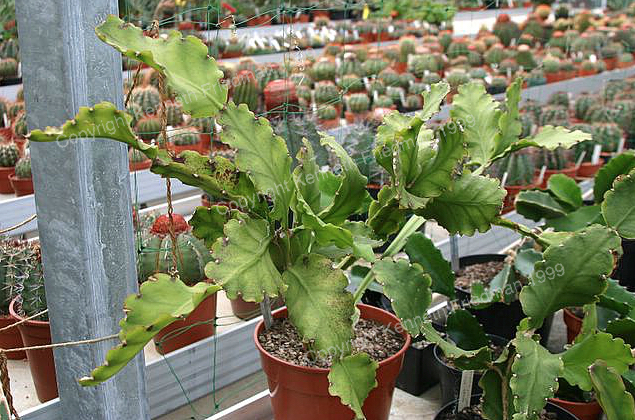
R. pachyptera (copyright Ken Friedman, Kew)
See Calvente Thesis 2010
10. RHIPSALIS PACHYPTERA Pfeiff., Enum. Diagn. Cact.: 132. 1837 .
TYPE: Curtis's Bot. Mag. 55: tab 2820. 1828 (lectotype in Barthlott
and Taylor,
1995).
Rhipsalis dusenii Hjelmq., Bot. Not. 4; 349. 1941.-TYPE: BRAZIL. Parana:
Jacarehy, "in silvula ad trunc. arb.", May 1915, Dusen 17074,
(holotype: S5470!; isotype: S04-768!, GH!).
? Rhipsalis pachyptera var. crassior Salm-Dyck ex Pfeiff., Hort. Dyck.:
59. .1849, nom. nud.
? Rhipsalis pachyptera f . rubra Suplie, Epi-flora 1: 16-17, 2005.
Rhipsalis agudoensis N.P.Taylor, Cactaceae Syst. lnit. 16: 12. 2003,
syn. nov.-
TYPE: BRAZIL. Rio Grande do Sul: Agudo, Horst-Uebelmann 821 , before
1989, cult. Hort. Uhlig-Kakteen, Germany (holotype: K!).
Epiphyte or lithophyte in mostly open habitat, 0.7-1 .5 m long, branching
apical, rare lateral. Stem segments flattened to triangular in longitudinal
section, 1-3.6 mm diam, medium green, succulent, stiff, dimorphic, midrib
3-5(-7) mm diam, cylindric; primary stem segments 8-40 cm long, wings
2-3, with cylindric base, 0.7-3 cm wide; secondary stem segments (8-)11-25
cm long, base acute, attenuate or truncate, apex truncate or rounded,
wings 2-3, (1.6-)2-7 cm wide,
margin crenate, rare serrate, plane to slightly undulate, with 6-16
mm projections. Areoles between margin projections, 1-5 cm apart, first
of segment 1-6 cm distant from segment base; when sterile 2-3 mm diam,
pilose, sometimes with vestigial scales; when fertile 2.8-4 mm diam,
dense pilose, with 1-numerous acicular scales, 1-9 flower/truits. Flowers
13-22 mm diam;
pericarpel 3-4 X 3-5 mm, turbinate, rare cylindric, greenish, glabrous;
with 1-4 sepaloid tepals, 0.6-2.5 mm long and 6-9 petaloid tepals, 2.5-11
X 2.5-5.5 mm, wide elliptic or elliptic, patent to sub-erect, whitish
or yellowish, external with reddish apex, apex rounded, curved inwards
to cucullate, margin curved inwards. Style 6-7 mm long; stigma with
3-6 lobes, 1.7-3.5 mm long, sagitate, erect to spreading. Ovules in
3-6 incomplete septa, funicle short (<0.1 mm). Stamens 60-70, 4-8
mm long, median or internal shorter, internal facing outwards and external
facing inwards, whitish. Nectary 1-1.3 mm long. Fruit 4.5-5 X 5-5.5
mm, globoid, white (pinkish or reddish when immature), glabrous.
Figures 2: A, C, G; 4: E, J.
Notes: R. pachyptera is well characterized by the stout stem segments,
mostly with truncate apices, marked secondary venation and large pilose
areoles. However, flowers present variable sizes, and the fruits can
also present varying colors, ranging from pinkish to white during development.
Given the high variation in fruit color observed in R. pachyptera, we
here treat R. agudoensis as a synonym given that these species used
to only be separated by the pinkish
fruits of R. agudoensis. Furthermore, the recognition of R. agudoensis
as a separate species would result in a paraphyletic R. pachyptera (fig
1). R. pachyptera is often confused with R. russelli when flowers and
fruits are lacking however, these species can be distinguished by the
larger flowers and usually whitish fruits of R. pachyptera, in contrast
to the small flowers and magenta fruits of R. russelli.
Habitat and distribution: Widespread through southern and southeastern
Atlantic Forest (Brazil). The occurrence at Agudo, further inland in
Rio Grande do Sul is only known from the registered provenance of the
type material of R. agudoensis, which was described after almost 15
years of
cultivation in Europe. Figure 10.
Rhipsalis pachyptera Pfeiffer, Enum. Cact. 132. (1837).
Desc from Hunt 2006.
Body resembling R. elliptica, but more robust; branches dichotomous
or verticillate; branch segments flat or 3-4 winged, broadly elliptic
to orbicular, up to 14x12cm, thick, often suffused purple, margins deeply
crenate; flowers 1-5(-13) per areole, rotate, 12x13-25mm, white scented;
stigma 5-8; fruit globose, 6mm diam, white, reddening in the sun
Details from B&R 1923
Synonyms
Cactus alatus Willdenow, Enum. Pl. Suppl. 35. 1813. Not Swartz, 1788.
Epiphyllum alatum Haworth, Suppl. Pl. Succ. 84. 1819.
Cactus triqueter Vellozo, Fl. Flum. 206. 1825. Not Willdenow, 1813.
Not Haworth, 1803.
Cereus alatus Link and Otto, Icon. Pl. Rar. 77. 1830.
Lepismium fluminense Miquel, Bull. Neerl. 48. 1838.
Rhipsalis robusta Lemaire, Rev. Hort. IV. 9: 502. 1860.
Rhipsalis pachyptera purpurea Corderoy, Gard. Chron. III. 2: 468. 1887.
Hariota triquetra Kuntze, Rev. Gen. Pl. 1: 263. 1891.
Hariota pachyptera Kuntze, Rev. Gen. Pl. 1: 263. 1891.
Hariota robusta Kuntze, Rev. Gen. Pl. 1: 263. 1891.
Rhipsalis crassa Schumann, Keys 54. 1903.
Stems much jointed, pendent; joints often 3 to 6 dm. long, 5 to 7 cm.
broad, thickish, stiff, sometimes nearly orbicular, often purple, deeply
crenate; flowers numerous, but solitary, rarely 2 to 4 from the areole,
large; Petals widely spreading, yellowish; stamens numerous; stigma-lobes
4 or 5, slender; fruit globose, white.
Type locality: Originally given as the West Indies, (* The plant, however,
which Hooker described and figured (Curtis’s Bot Mag 55: pl 2820
) as Cactus alatus and which Pfeiffer cited in his original description,
came from the Organ Mountains near Rio de Janeiro, Brazil.)
but this is doubtless a mistake.
Distribution: States of Rio de Janeiro, Minas-Geraes, Santa Catherina,
and Sao Paulo, Brazil.
The species grows in the high mountains on trunks of trees, altitude
1,000 meters, down to nearly sea-level.
A variety, crassior Salm-Dyck (Pfeiffer, Enum . Cact. 132. 1837), with
thick green orbicular
joints, has been described.
Steudel's name of Rhipsalis alata (Nom. ed. 2. l: 333. 1840), given
as a synonym of Cereus alatus De Candolle, is referred here by Schumann,
but probably relates to Pseudorhipsalis.
This species was for a long time confused with Rhipsalis alata, a very
distinct species from
Jamaica, now referred by us to the genus Pseudorhipsalis.
Notes from Bradleya 13
DISTRIBUTION. Brazil (Rio de Janeiro, Sao Paulo, Parana, Santa Catarina,
Rio Grande do Sul): epi¬phytic and epilithic in Atlantic forest,
common at low elevations.
Typical R. pachyptera is a primarily coastal plant, but a somewhat
different form, at times resembling R. oblonga, with narrower, elongate.
cuneate stem-segments, and restricted to the Serra dos Orgaos, at up
to 1800 m elevation (Rio de Janeiro state), is also provisionally included
in our present concept. It is possible that this merits recognition
as a subspecies or, when bet¬ter known, will demand altogether separate
sta¬tus. The same applies to another form collected by Werner Uebelmann
near Agudo, Rio Grande do Sul (in cultivation at Bonn, accn. no.06525),
representing an unusual, slender-stemmed, multi-winged variant, which
superficially resem¬bles R. russellii.
In Pfeiffer's Enumeratio Cact. 132. 1837:
Rhipsalis pachyptera
Pa: India occidentalis
E. articulis grosse nervosis, obtusatis, floribus sessilibus ad crenas
ramorum, tubo
brevissimo (L. et O.).
R. suberecta, alata vel triptera; ramis expansis magnis viridibus,
rubro-marginatis,
subrotundis vel elongatis, apice attenuatis, nervosis, carnosis, tuberculato-crenatis,
inermibus, rarius subciliatis, interdum e nervo medio bifarie radicantibus
Caulis saepe basi teres. Articuli crassi, plani, saepe 4 - 6 poll.
diam., alii tripteri, elongati,
Cereo triangulari valde similes, tamen cristis acutioribus, incisis,
inermibus, 4-5 poll.
longi, 2-3 diam.
Flores hiemales copiosissimi albidi, suaveolentes, 1 poll. diam.
Ovarium subglobosum, 2 lin. longum et crassum, laeve; petala 5-6 ventricosa,
4-6 lin.
longa, 2-3 lata, virescenti-alba.
Stamina numerosissima alba, stylo albo 4-partito vix breviora.
English translation:-
Habitat – West Indies
E. – large jointed, veined, sessile flowers from the scallops
of the branches, with very short tube (Link and Otto)
R – suberect, winged or three winged, branches spreading strongly,
green with red margins, round or elongated, tip attenuate, veined, succulent,
scalloped/wart-like, spineless, rarely with hairs, sometimes two rows
of aerial roots from the mid-vein
Stem – often tubular at base, thick joints, flat, often 10 –
15cm diam., winged to three winged, elongated, very similar to triangular
Cereus, nevertheless with sharp crests, deeply cut, spineless, 10 –
12cm long, 5 – 7cm diam.
Flowers – white very abundant in Winter, sweet smelling, 2.5cm
diam.,
Ovary – subglobose, 4mm long and thick, smooth
Petals – 5 – 6, asymmetric, 8 – 12mm long 4 –
6mm wide, greenish-white
Stamens – very numerous white, Style white, 4 lobes, very short.
Previous Page |
